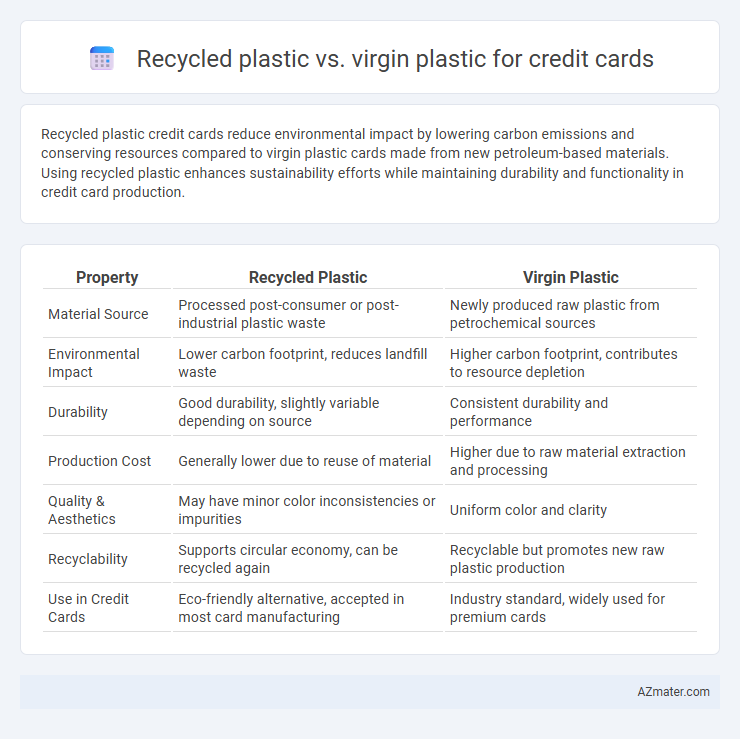Recycled plastic credit cards reduce environmental impact by lowering carbon emissions and conserving resources compared to virgin plastic cards made from new petroleum-based materials. Using recycled plastic enhances sustainability efforts while maintaining durability and functionality in credit card production.
Table of Comparison
| Property | Recycled Plastic | Virgin Plastic |
|---|---|---|
| Material Source | Processed post-consumer or post-industrial plastic waste | Newly produced raw plastic from petrochemical sources |
| Environmental Impact | Lower carbon footprint, reduces landfill waste | Higher carbon footprint, contributes to resource depletion |
| Durability | Good durability, slightly variable depending on source | Consistent durability and performance |
| Production Cost | Generally lower due to reuse of material | Higher due to raw material extraction and processing |
| Quality & Aesthetics | May have minor color inconsistencies or impurities | Uniform color and clarity |
| Recyclability | Supports circular economy, can be recycled again | Recyclable but promotes new raw plastic production |
| Use in Credit Cards | Eco-friendly alternative, accepted in most card manufacturing | Industry standard, widely used for premium cards |
Overview: Recycled Plastic vs Virgin Plastic in Credit Cards
Recycled plastic credit cards are made from post-consumer waste, significantly reducing environmental impact and resource consumption compared to virgin plastic cards, which rely on newly extracted petrochemicals. Both materials provide durability and flexibility essential for credit card manufacturing, but recycled plastics often incorporate additives to maintain strength and aesthetics. The shift towards recycled plastic credit cards supports sustainability initiatives and lowers carbon footprints in the financial services sector.
Environmental Impact Comparison
Recycled plastic credit cards substantially reduce environmental impact by lowering carbon emissions and conserving petroleum resources compared to virgin plastic, which relies on fresh fossil fuel extraction. Using recycled plastics diminishes landfill waste and decreases energy consumption during production, contributing to a smaller carbon footprint. Lifecycle assessments reveal recycled plastic cards emit up to 70% fewer greenhouse gases than virgin plastic alternatives.
Production Process Differences
Recycled plastic for credit cards is produced by melting down post-consumer or post-industrial plastic waste, reducing the need for new raw materials and energy consumption compared to virgin plastic production. Virgin plastic involves extracting and refining fossil fuels like petroleum or natural gas, followed by polymerization processes to create new plastic resin with consistent properties. The recycled plastic production process fosters sustainability by minimizing carbon emissions and landfill waste, whereas virgin plastic production demands higher energy input and generates more environmental pollutants.
Cost Analysis: Recycled vs Virgin Plastic
Recycled plastic for credit cards generally costs 10-20% less than virgin plastic due to reduced raw material expenses and lower energy consumption during processing. Virgin plastic, derived from petrochemicals, often incurs higher production costs because of fluctuating crude oil prices and intensive manufacturing requirements. Over time, recycled plastic can offer significant savings in large-scale production while supporting sustainability goals.
Durability and Performance
Recycled plastic credit cards exhibit slightly lower durability compared to virgin plastic cards due to potential impurities and weakened polymer chains, which can affect resistance to bending and wear over time. Virgin plastic cards, made from pure, high-quality polymers like PVC or polycarbonate, offer superior structural integrity and consistent performance under frequent use and exposure to environmental stressors. Despite these differences, advances in recycling technology have improved recycled plastic's strength, making it a viable, eco-friendly alternative with acceptable durability for most credit card applications.
Regulatory and Industry Standards
Recycled plastic used in credit cards must comply with stringent regulatory standards such as REACH and RoHS to ensure the absence of hazardous substances and meet safety requirements. Industry standards like ISO 7810 and PCI DSS mandate durability and security irrespective of the plastic source, promoting the use of sustainable materials without compromising performance. Virgin plastic offers consistent quality and easier certification processes but faces increasing regulatory pressure favoring recycled alternatives to reduce environmental impact in card manufacturing.
Consumer Perception and Demand
Consumer perception favors recycled plastic credit cards due to their environmental benefits, appealing to eco-conscious buyers seeking sustainable products. Demand for recycled plastic cards is rising, driven by increasing awareness of plastic waste reduction and corporate social responsibility initiatives. Virgin plastic cards maintain popularity for their perceived durability and quality, but growing environmental concerns are shifting preference towards recycled alternatives.
Challenges in Adopting Recycled Plastic
Adopting recycled plastic for credit card manufacturing faces significant challenges including inconsistent material quality, which can affect card durability and security features. Supply chain limitations and higher processing costs compared to virgin plastic impede large-scale adoption by financial institutions and card issuers. Regulatory compliance and certification for recycled materials also present hurdles in meeting industry standards for payment card production.
Future Trends in Sustainable Credit Cards
Recycled plastic is becoming a preferred material for sustainable credit cards due to its lower carbon footprint and reduced reliance on fossil fuels compared to virgin plastic. Innovations in biodegradable and bio-based recycled plastics are driving future trends, enhancing durability while minimizing environmental impact. Financial institutions increasingly adopt eco-friendly credit cards, aligning with growing consumer demand for sustainable products and stricter regulatory standards on plastic waste.
Case Studies: Banks and Brands Leading the Way
Banks such as American Express and brands like Apple have spearheaded the transition from virgin plastic to recycled plastic in credit card production, showcasing significant environmental benefits. Case studies reveal that American Express introduced the Green Card, made from 80% recycled plastic, reducing carbon emissions by up to 50% compared to traditional cards. These initiatives highlight how financial institutions leverage recycled materials to enhance sustainability while maintaining card durability and performance.

Infographic: Recycled plastic vs Virgin plastic for Credit card
 azmater.com
azmater.com